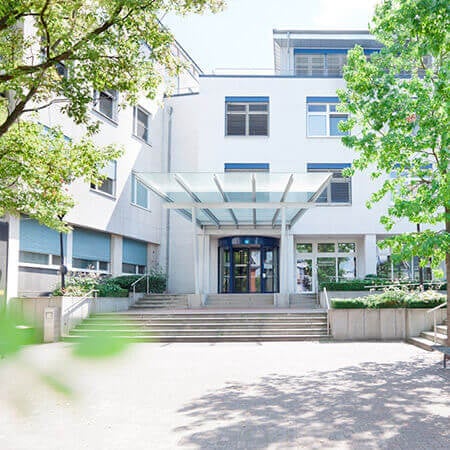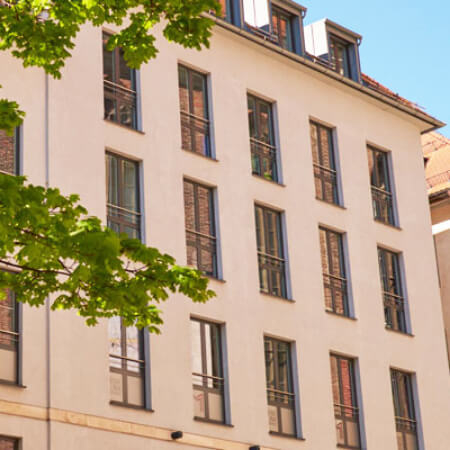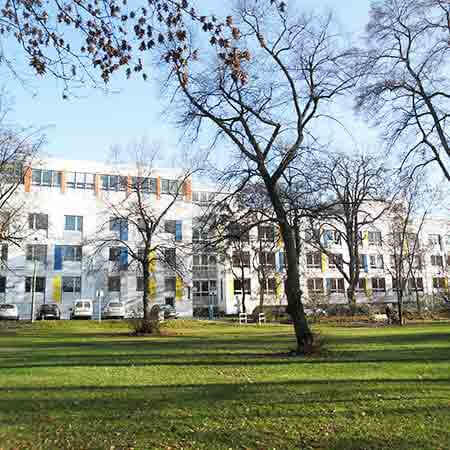Neuroblastoma is a malignant tumor that develops in infants or young children usually under the age of 10. At the early stages of development, tumor cells resemble nerve cells.
Content
- Overview
- Prevalence of neuroblastoma
- What causes neuroblastoma?
- Symptoms
- Diagnostics
- Treatment of neuroblastoma in children
- Prognosis
- Hospitals for neuroblastoma treatment in Germany
- The cost of cancer treatment in Germany
- How to undergo cancer treatment in Germany?
Overview
One third of neuroblastomas develop in the adrenal glands, the other third – in the abdominal cavity along the nerves of the spine, and the rest – in the chest cavity and on the neck. Sometimes, due to the spread of the tumor at the time of diagnosis making, it is difficult to establish where exactly the tumor has originated.
It should be noted that not all tumors of the nervous system are malignant. Ganglioneuroma is an example of a benign tumor.
Ganglioneuroblastoma is a mixed tumor that contains both malignant and benign areas. The immature (malignant) cells of this tumor can grow and activate the process of metastasis formation. Ganglioneuromas are usually removed surgically and then carefully examined under a microscope to see if there are any areas of ganglioneuroblastoma. If a ganglioneuroma is diagnosed, additional treatment is not required. In contrast, ganglioneuroblastomas are treated in the same way as neuroblastomas.
Neuroblastoma is an unusual tumor for many reasons. This tumor secretes a biologically active substance that causes atypical changes in the body, such as rotational movements of the eyeballs, muscle spasms, and persistent loose stools.
Neuroblastoma can also behave in an unusual way. Sometimes tumor cells disappear spontaneously. This phenomenon occurs most often in very young children and it is noticed much less often in older patients. In some cases, tumor cells become mature and stop dividing spontaneously. Thus, neuroblastoma turns into a ganglioneuroma – a benign tumor.
Prevalence of neuroblastoma
This tumor is considered most common in newborns and is also prevailing in toddlers, along with acute leukemia and malignant lymphomas. In boys, neuroblastoma occurs slightly more often than in girls. For every 6 cases of tumors in boys, there are 5 cases in girls.
The average age of patients at the time of diagnosis making is 17 months. One third of cases are diagnosed in children under 1 year of age. Almost 90% of neuroblastomas are detected before 5 years of age. Only 2% of tumors are found after the age of 10 years and in adult patients. In rare cases, neuroblastoma can be detected with ultrasound scan before the baby is born.
In 7 out of 10 cases, neuroblastoma has developed metastasis at the time of diagnosis making.
What causes neuroblastoma?
Currently, there’s no confirmed information on what causes neuroblastoma. However, connection is known between the development of neuroblastoma cells and level of maturity of normal nerve cells. This information is important in developing treatment schemes.
How responsive to therapy neuroblastomas are, which ultimately influences overall prognosis of recovery, depends on the level of maturity of the healthy nerve cells. Many researchers believe that neuroblastoma occurs when embryonic cells do not develop properly, but grow out of order.
Cells of the nervous system may not mature fully when a baby is born, and only small clusters of mature nerve cells are often detected in infants. Nerve cells can eventually mature and not facilitate neuroblastoma development. But in some cases, immature nerve cells continue to develop and cause the tumor formation that can even spread metastasis to various organs. However, such tumors often disappear eventually.
In a growing child, the likelihood of maturation of nerve cells lowers, and the likelihood of neuroblastoma development increases. When the neuroblastoma reaches a large size and symptoms appear, the maturation of cells stops, and they continue to spread, if not treated.
Some cancer patients have DNA mutations that they have inherited from parents, which doubles the risk of developing a tumor. Therefore, some family cases of neuroblastomas appear to be due to inherited gene mutations that stimulate tumor growth. However, most cases of neuroblastomas occur without inherited genetic mutations.
Symptoms
How a neuroblastoma will manifest itself depends on where the tumor is localized and on the spread of its cells throughout the body.
The tumor can affect the abdomen. Therefore, neuroblastoma can be suspected if there is pain in the abdomen and increase in its size. A child can experience bloating, discomfort or pain. The tumor can be located in other areas, for example, on the neck.
Neuroblastoma often affects bones. In this case, a child might even refuse to walk because of the bone pain. If the spinal area is affected, compression of the spinal cord can occur, leading to numbness or paralysis of the lower limbs. Every fourth patient may experience fever.
Less often persistent loose stools, high blood pressure, increased heart rate, and sweating are noted. These symptoms are caused by the hormone release from neuroblastoma cells.
Thus, neuroblastoma causes non-specific and various clinical manifestations, which makes diagnostics more challenging.
Diagnostics
If tumor manifestations and related symptoms are present, the specific testing is required in addition to other primary diagnostic methods. These include blood tests, microscopic tissue examination, and imaging methods such as CT scanning, magnetic resonance imaging (MRI), etc. Imaging methods are used to make the correct diagnosis and detect metastases.
Healthy nerve cells communicate with each other through the release of certain chemical substances. Catecholamines are among such substances. Catecholamines transform in the metabolic process and are further excreted through the urine. In almost all cases, neuroblastoma cells produce a certain amount of catecholamines due to which the tumor is identified by testing urine with special methods.
Moreover, as the catecholamine levels are increased because of the malignant process, specific symptoms may arise.
Treatment of neuroblastoma in children
A neuroblastoma diagnosis should be treated as soon as possible.
The stage of the tumor, the child's age, and prognostic factors determine the choice of a treatment method. Treatment can consist of surgery, chemotherapy and/or radiation therapy used alone or as a complex therapy. Some children benefit from the combination of several methods of therapy.
Usually, when choosing a therapy method for neuroblastoma, doctors consider the stage of cancer and the risk group a patient belongs to. There’re low-risk groups, intermediate-risk groups, and high-risk groups.
Often, low-risk patients only need surgery, except for some patients. Chemotherapy alone can be used for this group of patients.
Patients of intermediate-risk groups have 4-8 cycles of chemotherapy before or after surgery. Sometimes, a second surgery or radiation therapy is performed to eliminate completely what’s left from a tumor.
For high-risk groups of patients with metastasis formation, intensive chemotherapy is indicated along with the method of a bone marrow transplant.
Chemotherapy for neuroblastoma includes the use of cytostatic drugs suppressing the multiplication of cancer cells. Cytostatic agents disrupt the process of rapid cell division. For neuroblastoma, chemotherapy is a primary option when it is impossible to remove the neoplasm with surgery or when the process of metastasis formation is observed.
Sometimes, to prevent a recurrence, postoperative course of chemotherapy is indicated. For greater success and reduction of side effects of chemotherapy, the course usually includes the use of cytostatic agent combinations with different mechanisms of action.
However, chemotherapy drugs damage not only malignant, but also healthy cells. Therefore, different reactions may develop based on the type and dosage of the chemotherapy medication. Since chemotherapy drugs can harm the growing body of a child significantly, oncologists in Germany adhere to improved therapy protocols to protect young patients, reducing the toxic effect of chemotherapy.
Unfortunately, some patients after treatment of neuroblastoma can have a recurrence of cancer. In such cases, the treatment method is chosen taking into account the risk group and localization of the recurrent tumor.
Prognosis
In many children with neuroblastoma a recovery is possible.
Children with no metastasis and infants under one year of age have the best prognosis for recovery. Cancer in these patients can be treated with minimal therapy or disappear completely. Children with an active metastatic process and older children have less favorable prognosis.
However, to date, after modern methods of surgery, chemotherapy and radiotherapy, there’s usually no need for repeated treatment as therapy combination is considered highly effective.
Diagnosing neuroblastoma does not always increase the risk of a secondary tumor development. However, in some cases, the aggressive use of intensive therapy methods (chemotherapy or radiation) can promote the formation of a secondary malignant tumor.
Hospitals for neuroblastoma treatment in Germany
Among the best hospitals in Germany, there are hospitals that specialize in neuroblastoma treatment:
- Hospital Neuwerk Moenchengladbach
- Pediatric Diagnostic Hospital M1 Munich
- Academic Childrens Hospital Nuremberg
- University Hospital Frankfurt am Main
- University Hospital Heidelberg
See more about the hospitals for neuroblastoma treatment on the Booking Health website.
The cost of cancer treatment in Germany
Cancer treatment in Germany is one of the most common directions of medical tourism to Germany.
In cancer treatment in Germany, many factors can affect the prices for treatments. An oncological examination in Germany can reveal something that doctors in the native country may have missed, and this could result in a change in the price of treatment (make it both lower and higher) and affect the duration of hospital stay.
The cost of treatment of neuroblastoma in Germany with tumor resection starts at 28,854 EUR.
The cost of treatment of neuroblastoma in Germany with radiation therapy starts at 15,300 EUR.
The cost of treatment of neuroblastoma in Germany with chemotherapy starts at 6,547 EUR.
The cost of treatment of neuroblastoma in Germany with high-dose chemotherapy and peripheral blood stem cell transplantation for stage 4 cancer starts at 85,450 EUR.
How to undergo cancer treatment in Germany?
To have the diagnosis and undergo treatment of neuroblastoma in leading hospitals in Germany, contact the reputable medical tourism company Booking Health. Booking Health cooperates with leading German medical institutions.
Booking Health will help you to go for treatment as soon as possible and will do everything so that the treatment experience will be comfortable.
Leave a request on the Booking Health website, and a medical advisor will contact you and provide you with information on cancer treatment in Germany.
Authors: Dr. Nadezhda Ivanisova, Dr. Farrukh Ahmed





